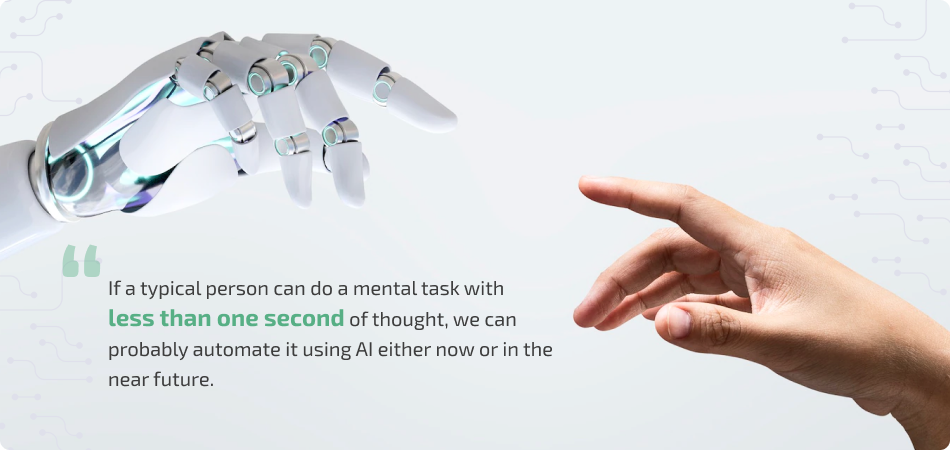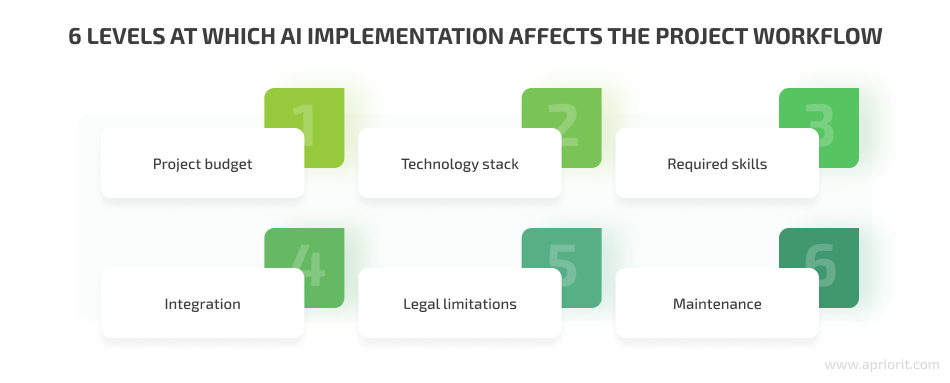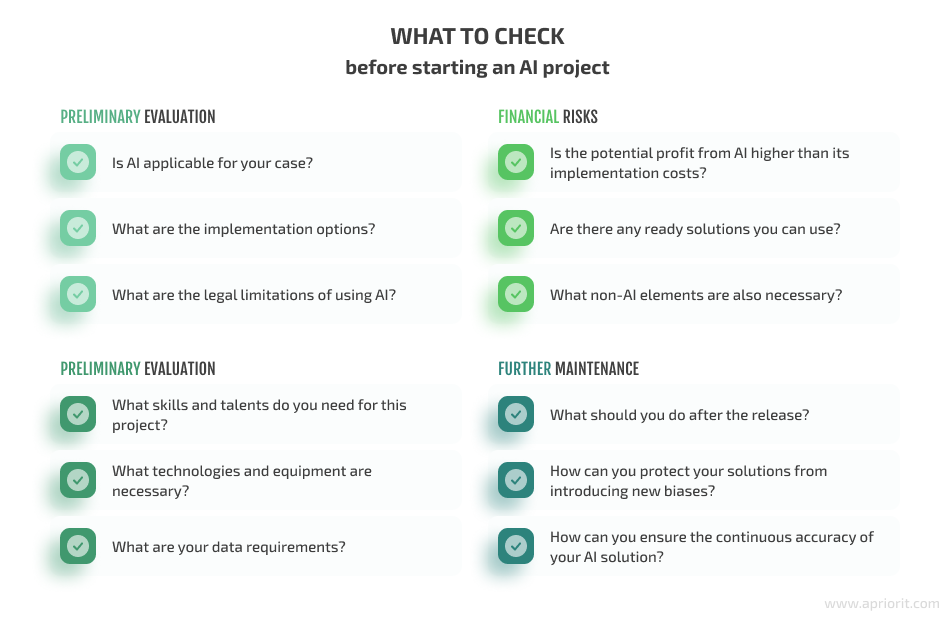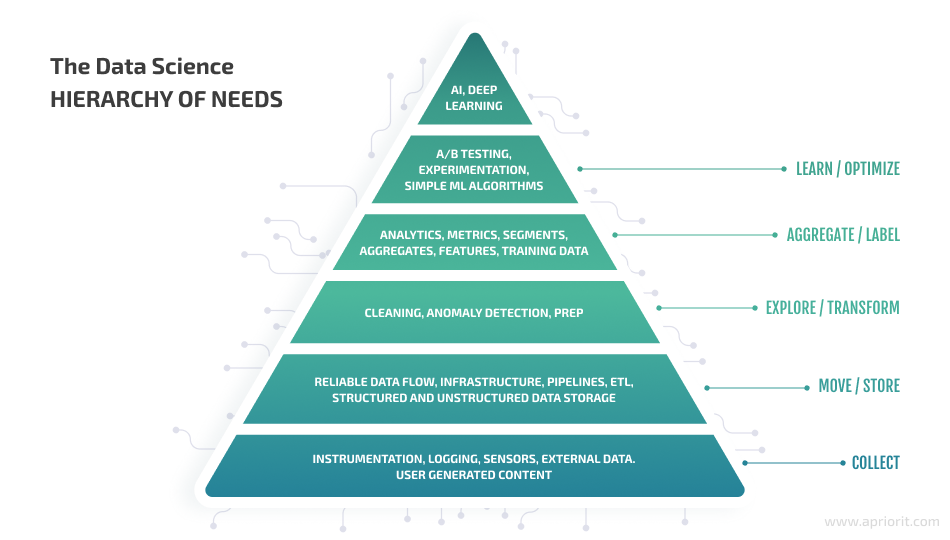Businesses aim to get smarter. Driven by different motivators, they often rush to join the artificial intelligence (AI) adoption race without properly assessing the need for AI technology. But when starting an AI project without proper preparations, organizations risk releasing a non-viable, under-performing product while wasting a lot of time and money.
In this article, we discuss why AI draws so much attention from organizations working in various regions and industries. We cover how to start an AI project, analyze the key traits of a sustainable AI project, and consider the challenges AI projects present for development teams. We also outline twelve questions any business should answer before starting an AI project in order to save their resources and increase the chances of a successful release.
This article will be useful to development teams and organizations considering deploying AI technologies for their projects.
Contents:
Business motivators for AI adoption
The variety of tasks AI can perform continues to expand, and so does the adoption of this technology by businesses. The first AI programs were the result of scientific projects and completed tasks like playing checkers or solving puzzles. Today, AI powers the operations of virtual assistants, email filters, and recommendation services, driving customer experience personalization and engagement to new heights. In fact, 86% of businesses saw artificial intelligence as a mainstream technology in 2021, reports PwC.
We can outline three key reasons why businesses consider adopting AI technologies:

Let’s look at each of these motivators.
Ready to adopt AI?
Secure yourself a reliable and experienced development partner to bring your advanced software to life with wisely chosen development approach and tools.
1. Customer demand
AI brings hyper-personalization, but it’s not always what your customers are asking for.
Customer needs and demands are among the key drivers of innovation for any business. People expect modern products to be high-performance, super efficient, and deeply personalized while staying affordable. And many businesses believe that AI is the right technology to make this happen.
By continuously learning on huge volumes of behavioral and historical data, AI-powered solutions allow businesses to study and truly understand the needs of their customers. This eventually enables hyper-personalization of products and services, making the words exactly what you need more than a marketing slogan.
Non-AI solutions usually provide recommendations based on a person’s demographic data and purchase history, thus often resulting in mismatched suggestions. For instance, if a person has recently bought a new car, non-AI solutions would most likely continue showing that person lots of vehicle ads. In contrast, the use of AI allows businesses to determine a customer’s intent based on the way the customer interacts with the website or application. So that someone who’s recently purchased a new car will see an advertisement of a neighboring car station, in-car accessories, or vehicle insurance services, but not the advertisement of yet another car.
The tricky thing here is that people usually don’t ask for the AI itself. Instead, what they are really looking for is either a certain level of experience or an end result that can be achieved in many ways, including with the help of AI.
In some industries, there might even be a situation where customers would choose a non-AI alternative over an AI-powered solution or service due to lack of trust or personal misconceptions about AI. One example of such an anti-innovation tendency was described in a recent study by NYU Stern and Boston University. A group of scientists studying the application of AI for medical purposes discovered that people are actually willing to pay a higher price for healthcare services in order to be examined by a human doctor instead of an AI system.
2. Competition
Not all businesses advertising the use of AI actually work with this technology.
Some businesses start building a new AI solution only because their competitors claim to offer the same. But commercials aren’t always true. A more efficient approach would be to evaluate your need for AI based on the tasks at hand.
Complex tasks that involve processing tons of data — generating a virtual reality, building a predictive forecast, detecting an anomaly, writing a piece of music — usually present objective technological reasons for AI adoption.
But for tasks where setting a number of strictly defined rules is enough — filtering data records, classifying files, making complex calculations — using non-AI algorithms might be a resource-saving choice.
3. Market trends
The line between leading a trend and hyping something up is thin.
The market sets trends for everything, from technologies to color palettes and word choices. And a survey by McKinsey shows a convincing trend of steadily growing AI adoption by businesses: in just a year, the number of companies with at least one AI-powered functionality in their solutions increased by 6 percentage points, from 50% in 2020 to 56% in 2021. And if in 2022 experts from Statista expect the global market of AI software to reach over $51 billion, by 2025, their forecast is as high as $126 billion.
Seeing these numbers, it’s easy to fall into the hype trap. Positively framed forecasts and overviews of market trends can create a false impression of guaranteed success. However, global market trends should never be treated as personal guarantees of commercial success. To build a sustainable and profitable business, it’s crucial to offer a solution that brings true value to end users.
Yet when you decide to enhance your solution with AI capabilities, there are several ways you can use market trends to your advantage.

To get the full picture of AI adoption by businesses in different industries and understand possible applications of this technology, take a look at our whitepaper below.
In the next section of this post, we discuss how to make a practical AI project, focusing on the key criteria distinguishing sustainable AI solutions from non-competitive ones and how the decision to adopt AI might affect your project’s workflow.
Related project
Building AI Text Processing Modules for a Content Management Platform
Explore how our AI text processing modules empowered a global content management provider to enhance their platform and delight users worldwide. Discover the impact of AI-driven translation, generation, and formatting on user experience and platform efficiency.

Why is it difficult to build a sustainable AI solution?
Three AI projects out of ten make it to the production stage. Only one out of those three actually brings profit.
That’s the reality described in a recent survey of 2,000 IT decision-makers and professionals conducted by IDC. About 69% of today’s AI projects are still at the evaluation, experimentation, or prototyping stage.
It’s clear that delivering a sustainable AI-powered solution is challenging, but why is that so?
Let’s analyze this problem at two levels, starting with the key traits of a strong AI project.

1. Implementability
The very first marker of a sustainable AI project is whether it can be delivered at the moment. James Cameron had to wait almost 15 years for technology to reach the level he needed to make his Avatar movie, and some AI projects can simply be too ambitious for today.
Therefore, whenever you consider a new AI project, it’s important to take into consideration three major parameters:
- Technology — Having the tools and equipment necessary to implement your AI idea is crucial for your project’s success. If there are known cases of solving a task similar to yours with the help of AI, then you have little to worry about. The highest risks come with tasks that have never been attempted with AI before.
- Data — An AI system won’t be able to properly solve any task if not fed enough quality data. To be marked as quality, data should be complete, clean, readable, and free of bias.
- Skills — Just having all the needed tools, equipment, and data isn’t enough. You also need a team of qualified, experienced AI professionals who know how to manipulate all these tools and data to the advantage of your project.
Lacking any of these three parameters may compromise your project’s viability.
2. Viability
Any AI project should be viable. Building an AI project requires tons of resources, from time and money to data and unique skills. Starting an artificial intelligence project when you aren’t sure whether it’s viable would be a waste of all these resources.
To have a chance at survival, a project should:
- Bring sufficient profit early, or
- Have enough funds to keep running until it starts bringing profit
And to become profitable, your project needs to bring value.
3. Value
As summarized by Andrew Ng, an AI project can bring value in several ways:
- Save costs by cutting capital or operating expenses
- Bring extra revenue by improving the system’s efficiency or increasing sales
- Enable new lines of business by launching revolutionary projects that weren’t possible before
We can expand this list with one more possible improvement:
- Improve the customer experience by enhancing the quality and performance of your service or product
But to enable all these value-generation options, you need to first determine what particular business or technical task you want to accomplish. Once you define it, you can determine whether that task can and should be accomplished with AI and what type of value it can bring.
4. Efficiency
When choosing which tasks to apply AI for, you can rely on the one-second rule:

If you plan to leverage AI capabilities for several tasks, it’s best to start with the ones you can finish quickly and with a high chance of success.
On the one hand, such an approach will help you better understand if AI is the right tool for your project. On the other hand, having a successfully released AI project — even if it’s only a minor improvement of your existing workflows — could serve as a convincing argument for increasing the budget for your next AI integration ideas.
Read also
AI and ML for Fraud Detection: Top Use Cases, Approaches, and Technologies
Protect your data with AI-powered fraud detection. Discover industry benefits and essential technologies for effective implementation of AI and ML in real-world examples.

5. Fitting niche
Having several accomplishable tasks isn’t enough to build a sustainable AI solution, though. You need to make sure that all these tasks are relevant to your target audience as well as the industry and region in which you operate. For instance, depending on the age of your target audience, you might need to make certain choices regarding the application’s interface. And if you’re working in a strictly regulated industry — like healthcare or finance — you will have to account for additional data protection measures when designing the product architecture.
Addressing unique customer requests allows you to occupy a niche with less competition, increasing your project’s chances at success. It also makes it easier to convince your stakeholders and potential investors to support your initiative.
6. Long-term cost-efficiency
Finally, while many AI projects might seem to be competitive and help cut costs right after their release, not all of them can maintain this cost efficiency in the long run. Continuous optimization of a company’s expenses becomes possible when an artificial intelligence solution does at least one of the following:
- Automates and optimizes processes — AI has proven to be an efficient tool for automating routine tasks, improving data management, and optimizing corporate workflows, which can lead to a significant reduction of administrative overhead.
- Provides data-driven forecasts — Predictive analytics and AI-generated forecasts provide unexpected insights from large volumes of data, enabling business stakeholders to make efficient, data-driven decisions.
- Reduces human errors — AI-powered automation also reduces the number of human errors, improving the quality of delivered products and services as well as mitigating risks associated with the human factor.
As you can see, building a sustainable AI product is a true business challenge. But working with AI technologies also has a significant impact on the workflow of an AI solution development team. Let’s take a closer look.
The impact of AI integration on a project workflow
Before deciding to integrate AI technologies into your product, you need to assess the impact this decision will have on your team and the overall project.

- At the project budget level, working with AI technologies often brings additional expenses that are difficult to forecast. Developing an AI solution is often a matter of running continuous experiments with multiple trials and failures. The scope of the required tools, technology, infrastructure elements, and skills can be changed several times throughout the project, affecting the budget accordingly.
- The project’s technology stack is directly influenced by the machine learning models, algorithms, and services you’re planning to work with. This is especially challenging for hybrid solutions, where only one or several functionalities are powered by AI. When choosing or changing the set of tools, services, and solutions for the AI part of the product, software engineers often have to take into account limitations of the product’s non-AI part.
- While AI is a trending technology that many IT professionals are interested in, talent shortages are a common issue. It’s challenging to get all needed specialists, partially because the set of skills required of engineers might change several times over a project’s lifespan. For instance, over the course of an AI project, there might be significant changes in the chosen development approach, final solution architecture, or technology stack, and any of these changes will inevitably affect the set of skills needed to accomplish the project.
- AI projects often face significant integration issues. Usually resource-hungry, innovative AI solutions might have a poor compatibility profile. Some solutions are just too complex to be integrated into general systems and provide a satisfying customer experience. Others might consume too many resources or be incompatible with the rest of the software and services deployed in the customer infrastructure.
- Aside from technological challenges in AI adoption, many AI solutions also face significant legal limitations. As AI systems are heavily data-dependent, they must comply with a wide range of data security and data privacy requirements. Another common issue is the unexplainable nature of the decision-making process in some AI systems — particularly, so-called black box AI systems, when you know the inputs and outputs of the AI system but have no understanding of the internal workings. Due to this lack of transparency, the use of AI solutions can fall under certain limitations or even restrictions in specific regions and industries.
- Similarly to traditional software, AI services require proper maintenance. Ongoing testing of AI algorithms and improvement of existing functionality, delivery of new features, and quality customer support are vital for ensuring the sustainability of an AI project.
Building a viable AI product requires a deep understanding of your business objectives and possible limitations, both technological and legal. That’s why we’ve outlined twelve questions to answer before deciding to enrich your solution with AI capabilities or before building your first AI project.
Related project
Building an AI-based Healthcare Solution
Discover how our AI-based system revolutionized ovarian follicle tracking for a US healthcare center, achieving 90% precision and a 97% recall rate. Find out how Apriorit’s work helped our client improve patient care and accelerate fertility treatments.
12 questions to ask yourself before starting an AI project
Any journey starts with checking if you have everything you might need during the trip — even if it’s a journey of building an artificial intelligence‒powered solution.
Below, we outline twelve key questions worth asking before you start doing an AI project:

Let’s take a closer look at each consideration.
Preliminary evaluation
First and foremost, you need to validate if artificial intelligence is the right choice for your project or for a particular task.
1. Is AI applicable for this case?
You need to clearly determine your objectives for the task at hand and see if they can be achieved with and without the help of AI. Check out our recent article with the overview of LLM use cases, if your project requires text processing and communication with users.
There are two possible scenarios where the use of AI won’t be reasonable:
- The desired results can be achieved without the use of AI — In this case, using AI for the sake of AI wouldn’t be a smart choice. Instead, you should look for other cases where the adoption of artificial intelligence can bring significant benefits to your business.
- Existing AI technologies can’t solve the task at hand — Investing time and money into researching revolutionary AI solutions is risky and doesn’t guarantee positive results. So for the sake of business sustainability, it’s best to only apply known AI capabilities for solving specific tasks and leave scientific experiments to researchers.
Meanwhile, the golden case for starting an AI project is when AI either is the only technology you can use to solve the task at hand or it works faster or at a lower cost than any non-AI alternatives.
2. What are the implementation options?
Next, you need to evaluate your available implementation options. The most common scenarios are:
- Deployment of ready-to-use AI algorithms or models — You can use this approach when ready solutions can solve your task at hand without any customization of the algorithm or model. If the task is too complex to be solved with one ready solution, you might also try splitting it into several simpler ones and look for fitting algorithms for each of these subtasks.
- Customization of a ready solution — More often than not, a ready dataset or pretrained model won’t fit your project goals out of the box. In this case, you will need to run some adjustments before using ready AI solutions or components, such as improving data labeling in a dataset, expanding the dataset with new data, or training a ready model on custom data.
- Development of a custom AI solution — This scenario is rather challenging and expensive and usually arises when you work on complex, unprecedented use cases. However, even the most unique and complex AI projects usually can be split into several smaller tasks. And among those smaller tasks, only a few would actually require building a custom AI from scratch.
You might try choosing one scenario that can bring you the best results at a lower price, or combine these approaches to implement different parts of your AI project.
3. What are the legal limitations of using AI?
Last but not least, make sure there are no legal or compliance restrictions that prevent you from using AI in your project.
Here, we can outline several key aspects to pay attention to:
- Data privacy — As AI solutions often operate with real-life data, your job is to ensure that data use is consensual and that all personal information is properly anonymized.
- Data security — For data that can’t be anonymized, you should establish additional security measures. Your development team needs to make sure that no one can access, process, or alter your AI’s sensitive data without proper authorization.
- AI explainability — In many countries, there are specific requirements as to the quality and explainability of AI solutions. For some industries, like finance or healthcare, the requirements might be harsher than for others. This is all done to ensure that black-boxed AI solutions that lack transparency in their decision-making processes aren’t prone to bias. Requirements to consider include the Algorithmic Accountability Act of 2019, Ethics Guidelines for Trustworthy AI, and the General Data Protection Regulation.
- Terms of use — When you deploy a ready AI component or solution, pay special attention to the terms and conditions regulating its use. Some open-source AI components and models might have restrictions regarding the field of use or territory in which they are used, ethical limitations, etc.
Make sure there are no legal limitations to using AI technologies in your project, and design your solution with data security and privacy in mind.
Read also
How to Build a Context-Aware AI Chatbot: Development Challenges and Solutions from Apriorit Experts
Unlock the potential of AI chatbots for your business. Discover how to overcome LLM limitations with practical examples using Python and LangChain.

Financial risks
Once you determine there are no legal restrictions on using AI, make sure to assess possible financial risks of your project.
4. Is the potential profit from AI higher than its implementation costs?
There are many factors that can affect the cost of AI functionality:
- Software requirements — The final purpose, complexity, and performance requirements of the software under development have a direct influence on the choice of data, technology, and skills for the project and, therefore, the project’s budget.
- Type of data used — Structured data is usually less expensive to work with than unstructured data.
- AI algorithm performance — Building an AI algorithm with a high level of accuracy and performance usually requires running several rounds of training and tuning, which leads to increased expenses.
But the real challenge is to make sure that the initial cost of implementing AI doesn’t exceed its potential return on investment (ROI). This is especially true for projects requiring the development of an AI solution from scratch. Conduct deep research of the solution’s implementability to determine if it can be developed and at what cost.
5. Are there any ready solutions you can use?
As we discussed above, usually there’s a ready solution you can use in your project — either out of the box or with some amount of customization. At Apriorit, we have wide experience enhancing and speeding up our AI projects with the help of ready-to-use datasets and AI models. In one of our projects, we used the Inception V3 convolutional neural network (CNN) model pre-trained on the ImageNet dataset to detect particular actions in video sequences. You can read more about this project in our Using Modified Inception V3 CNN for Video Processing and Video Classification and Applying Long Short-Term Memory for Video Classification blog posts. And to learn more about working with images, check out our article that explains possibilities for image recognition using AI.
In some cases, the use of ready solutions can help you cut costs and speed up product development. However, customizing a ready solution also might be expensive, so you need to keep this risk in mind as well.
6. What non-AI elements are also necessary?
Some experts stress that non-AI elements can turn out to be even more expensive than the AI itself, at least when you estimate the cost of an AI with the cost of the specialists whose skills you need to build it. For instance, up to 70% of a project’s budget might go not to the AI functionality itself but to the arrangement of proper data storage and management.
The most important non-AI elements you need to account for when planning your budget include:
- AI project infrastructure — Data storage and management, networking, orchestration and pipelining systems
- Data protection measures — Data security-oriented architecture, data access management tools
- API development — To increase deployment capabilities of your solution, it’s important to build a properly secured and well-performing API for it.
Required resources
Skills, technologies, equipment, and data are the pillars of any AI solution. A lack of any of these four things can compromise the entire project. Therefore, you need to take care about them in advance, starting with answering the following questions:
7. What skills and talents do you need for this project?
The range of skills and competencies needed to deliver a sufficient AI solution depends heavily on the project’s objectives. However, the core set of specialists usually includes:
- Business analyst to accurately determine business needs and customer demands relevant to your project
- AI engineers to build algorithms and AI models
- Data engineers to build reliable and secure data pipelines
- Software developers to build non-AI solution components
- DevOps engineers to build a stable infrastructure and ensure smooth integration of your AI models
- Quality assurance specialists to enable continuous testing and improvement of your AI solution
The range of required specialists and expertise might change as your project evolves. You might also need non-AI consultants to ensure that your product fully meets end users’ expectations.
8. What technologies and equipment are necessary?
Technical viability is a crucial part of any AI project. Your AI development team should examine what technologies, equipment, and data are needed to make sure the project is feasible.
Core things to check before starting development include:
- Readiness of AI algorithms
- Availability of pretrained AI models
- Availability of datasets with structured and unstructured data
- Access to necessary AI hardware
If not taken care of in advance, the lack of needed equipment and technology might compromise the development and launch of your product.
For instance, the power of your hardware can be increased with the help of additional tools. You can learn more about ways we’ve used Google Colaboratory for this task in the article below.
Related project
Leveraging NLP in Medicine with Custom Model for Scientific Reports Analysis
Explore how our AI-powered NLP integration enabled a medical research client to extract critical information from clinical text, accelerating their scientific research process. This software allows their analysts to concentrate on more complex tasks and improve diagnosis accuracy.

9. What are your data requirements?
To better understand your data needs, you can use the data science hierarchy of needs, first offered by Monica Rogati. As with Maslow’s classic hierarchy of needs, you need to start from the very bottom and slowly move upwards, meeting each of the data needs of your AI project.

If you try starting from the top of this pyramid, you might find yourself in a situation where your AI turns out to be malperforming, biased, and inefficient due to a lack of quality data.
How do you assess data quality?
There are many ways you can determine whether the data you’re about to use for an AI project is of good quality. We suggest paying most attention to the following four criteria:

1) Sufficient quantity
Evaluate what sources of data you have, how much data you can get from them, and of what quality. Your goal is to get enough data to train, validate, and test your model. It’s a good practice to split your dataset into three parts before you start creating an AI project so that training and testing data won’t get mixed, for instance.
If you don’t have enough data to feed your AI model, consider multiplying the data you already have with augmentation techniques. These techniques allow for expanding AI model training datasets by making minor changes to existing data. We relied on this approach when we needed to improve the accuracy of an AI model to classify types of skin cancer.
2) Trustworthy sources
The origins of your data have a direct impact on its quality and, therefore, on the performance of your AI solution. It’s important to aim for the most relevant resources, like patient records for healthcare solutions or agricultural satellite imagery for agricultural projects.
You can leverage data coming from either primary or secondary sources.
Primary sources are those originating from your own organization, such as customer relationship management or enterprise resource management platform records.
Secondary sources include your business partners and third parties, commercial databases, and publically available datasets. Data from these sources serves best for enhancing the quality of data from your primary sources.
3) Proper labeling
Artificial intelligence systems study data through labels and tags. A model trained on properly labeled data can learn to detect the same patterns in unstructured data with no tags. And the more precise the labeling of training data, the higher the accuracy of your algorithms and models.
Data labeling is a must for AI projects leveraging data from primary sources. Your AI team might also need to improve data labeling of ready datasets to make sure that tags fit the objectives of your algorithms. Data can be labeled either manually or with the help of dedicated software.
When building an AI system that can automatically detect, segment, and measure follicles in ultrasound images, we engaged therapists on the client’s side to ensure the high accuracy of data labeling and compose a dataset with high precision and excellent quality. In cases like this, data should be processed and checked manually to ensure maximum accuracy of assigned labels.
In our Action Detection Using Deep Neural Networks: Problems and Solutions article, you can learn more about our experience working with annotation tools to label data for our custom AI training dataset. Also, check out our article about using deep learning in automotive industry.
4) Free of bias
Machine learning solutions can generate inaccurate and unfair outcomes if they are biased. And data is one of the three main sources of bias in AI, along with algorithms and AI goals.
It’s difficult to keep your data 100% free of bias. But you need to put effort into keeping the level of bias in your AI model as low as possible.
Data bias can be either statistical or cognitive. The first comes from the use of irrelevant and unrepresentative data that has little to do with the data your solution will work with after release. Cognitive bias usually makes its way into your software at the stages of data selection or labeling, reflecting the misconceptions and prejudices common for a particular society. As a result, you get an unbalanced dataset where certain features are overrepresented or underrepresented.
Further maintenance
Successfully releasing an AI solution is only half of the deal, as you need to continuously maintain your AI model’s proper performance to keep your customers satisfied in the long run. And as support and maintenance also require significant resources, you need to plan for this activity long before the actual development of your AI solution begins.
Here are the few aspects we recommend paying attention to:
10. What should you do after the release?
You need to make the monitoring and maintenance of your AI solution a continuous process. Only then can you ensure proper performance, strong data protection, and a high level of customer satisfaction.
Key post-release activities include:
- Performance monitoring to quickly detect and fix minor issues
- Continuous quality control to prevent the performance of your AI model from degrading
- Regular retraining on new datasets to prevent model drift
Aside from these activities, it’s important to pay special attention to the level of bias and the accuracy of your AI model.
11. How can you protect your solutions from introducing new biases?
As AI models often get retrained with new data after the initial release, it’s important to keep watching for biases in them. From the technology point of view, you can address the problem of bias on two levels:
- Algorithms — Follow industry and government recommendations to increase the transparency and fairness of your algorithms. Cross-check them against different datasets to detect possible distortions.
- Data — Increase data quality and diversity in your datasets and test your models using data that’s different from the data they were trained on.
It’s easier to prevent and fix biases in solutions based on explainable AI algorithms. But the accuracy of black-boxed models can also be checked and improved.
12. How can you ensure the continuous accuracy of your AI solution?
As with any traditional software, it’s crucial to ensure that your AI solution can perform smoothly under different loads and that all valuable data is properly secured. But what’s even more important is to continuously check and improve the accuracy of your model.
We’ve already discussed that some AI solutions are black-boxed, meaning that it’s difficult or impossible to explain how a model came to a particular conclusion. However, there are several metrics you can use to ensure that even black-boxed models work as intended:
- Classification accuracy, which compares the number of correct predictions to the overall number of predictions made by your model
- Mean absolute error, which evaluates the difference between the prediction and the true value of a particular observation
- Logarithmic loss or log loss, which evaluates the accuracy of a data classifier
- And more
Depending on the specifics of your AI project, you can use different metrics and approaches to evaluate and improve the accuracy of your algorithms and models.
Conclusion
Artificial intelligence is a technology that continues spreading across industries, improving existing solutions and enabling new business cases. Whether you’re building on-premise software, or a custom CRM SaaS solution for your company, you might need to enhance it with AI. However, not all tasks require the use of artificial intelligence algorithms.
If done for the wrong reasons, adopting AI may result in poor outcomes and increased expenses. That’s why, before starting an AI project, we recommend you first evaluate your idea from four key perspectives:
- Is AI the right choice for your project?
- What are the possible financial risks?
- What resources will you need?
- How can you maintain your AI-based solution after its release?
At Apriorit, experts in business analytics, software development, data engineering, and quality assurance join forces to bring your business vision to life and help you build a viable, reliable, and competitive product. You can turn to us for advice on how to launch an AI project, evaluate the potential for AI adoption, or look for more efficient alternatives.
Let’s build AI-based software for your business!
Reach out to get a personalized consultation and start planning an AI solution that meets your business goals and needs.


